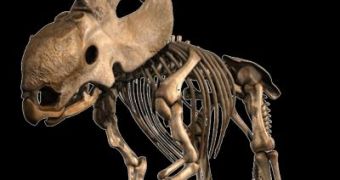The 72.5 million-year-old fossils that were uncovered in Canada belonged to a herd of a previously unknown species of dinosaurs, which has been named Pachyrhinosaur lakustai, in the honor of professor Lakusta, who first excavated in Alberta during the '70s.
The name Pachyrhinosaur (thick-nosed) comes from the bony formations that the newly discovered animal had on top of its nose and eyes. Dr. Philip Currie, palaeontologist and Canada Research Chair of Dinosaur Palaeobiology from the University of Alberta said that the head of the fossil was adorned with tiny horns and that, most likely, the entire structure was used as a support for larger keratin horns, which have since decomposed.
The best part about this new discovery is that the dig sites revealed many, almost perfectly preserved specimens, including adults and youngsters, of both genders. Paleontologists are now trying to determine the social structure of the herd, as well as the changes they underwent as they got older. The fact that such large numbers were found only helps to increase the chances for successful analysis of the bones, as well as of possible behavior types and growth patterns.
Though no one knew it until professor Lakusta began digging, the northern area of the Alberta province is actually very rich in rock beds dating as far back as the upper cretaceous period, some 70 million years ago. Grande Prairie Regional College, the Royal Tyrrell Museum and the University of Alberta are cooperating in the Pipestone Creek Dinosaur Project, which is meant to develop the entire area in terms of science, education and tourism. It was only by these institutions working together that scientists had enough support to uncover more and more dig sites throughout the region.
"The excavations at Pipestone Creek provide us with many rewards. Working on a previously unknown site that is abundant in dinosaur material shows how rich the entire province of Alberta is in palaeontological resources." said Andrew Neuman, executive director of the Royal Tyrrell Museum of Paleontology.

 14 DAY TRIAL //
14 DAY TRIAL //